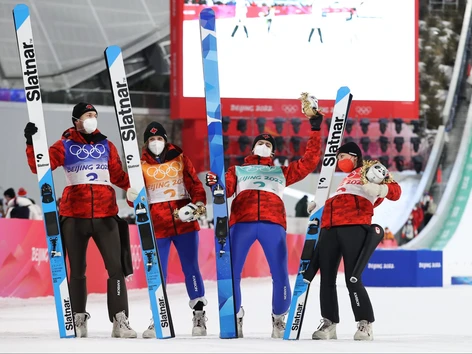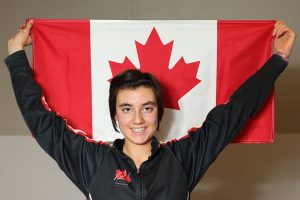Canadian ski jumpers still flying high in Europe
Author of the article: Dan Barnes • Postmedia

The Canadian women who jumped into the country’s consciousness during the Beijing Olympics last year are still flying high 10 months later.
Ski jumpers Alexandria Loutitt and Abigail Strate — one half of the bronze medal-winning Canadian team in China — have already combined for seven top-10 finishes on the World Cup circuit this season.
Strate, 21, was fourth in Lillehammer, Norway and Titisee Neustadt, Germany; sixth in Villach, Austria; and eighth in Ljubno, Slovenia last weekend. Loutitt, 18, skipped the early part of the season to finish her recovery from a fractured right foot, then promptly finished fourth and ninth in Villach and fourth in Ljubno. She also set a hill record in Villach and won a qualifying round in Ljubno.
It’s a rock-solid continuation of the momentum they created at the Olympics, where they joined up with fellow Calgarians Mackenzie Boyd-Clowes and Matt Soukup for a surprise trip to the podium in the team event.
“It feels pretty good because when Abi and I first started to compete with Janko (Zwitter) as our coach, we were fighting to qualify, so we were fighting for that top-40, top-30 position,” said Loutitt. “Now Abi and I are fighting our way to the podium and it feels really good that it’s not just one of us. You kind of have a buddy there with you. On the hill we’re competitors but afterwards we can cheer each other on. We’re always there to give each other a high five at the bottom or a fist bump at the top. If someone is going to kick me out of the leader box it better be her.
According to Ski Jumping Canada president Mike Bodnarchuk, the early results are also proof positive that Zwitter has made an impact on the Canadian women’s squad, which includes 24-year-old Natalie Eilers and 22-year-old Nicole Maurer. All four are from Calgary but they live almost full-time in Slovenia, one of the sport’s hotbeds, to better facilitate training under Zwitter’s guidance.
“He’s done some amazing things bringing them around,” Bodnarchuk said of Zwitter, a 50-year-old Austrian who previously coached Japan’s Sara Takanaski, a perennial medal-winner, and was also national women’s team coach for Austria and Italy. “They have bought into his program wholeheartedly, they believe in it and it’s clearly bearing results.”
“I’ve had good coaches in the past,” she said. “I think Janko also sees us as his daughters. He’s always there for us. He’s willing to support us and he believes what we’re telling him. If we’re really tired, or if this weight program is going to be too much and I won’t be able to perform this weekend if we do this, he’s like ‘OK, we’ll switch it up; you’re the one who knows what you’re feeling.’ He really encourages us to think about our mental health and our physical health and our general well-being. He’s really understanding when we do need a rest day or a break or if we are injured. He wants to help us improve and see us succeed.”
Loutitt missed the podium by a mere .4 points in Austria and .7 in Slovenia, while Strate was off by 2.8 in Norway and 2.9 in Germany. With such thin margins, Loutitt can easily spot the improvements that would give her a path to the podium.
“It definitely says I have to work on my style because the distance is there.”
In ski jumping, five judges award marks as high as 20 for style and charge deductions for mistakes in the air and on the landing. Loutitt said she was getting 16s and 17s for style when she should have been scoring 18s based on her healthy distance numbers.
“I was a little bit disappointed, but you always have to have something to work on or it’s too easy,” she said. “My body position in the air is strong, the landing and finish needs work, and that’s what led to the crash.”
She was in contention during the first of two competitions in Ljubno, in sixth place after the first round, when disaster struck and she wiped out on the landing of her second jump.
“A little bit of instability and poor conditions and I just turned into a penguin,” she chuckled. “That probably would have been a top-five again.”
Instead, she wound up a distant 24th, her worst finish this season. Even so, her four-jump aggregate score left her eighth overall in the prestigious Silvester Tournament, while Strate was 12th. The only other countries with at least two jumpers in the top 15 were Austria, Germany, Norway, Slovenia and Japan, basically the sport’s powerhouses. Loutitt believed she belongs in that conversation, and now she’s proving it.
“I wasn’t quite 100% ready for Lillehammer at the beginning of the season. Although it is one of my favourite hills and I performed really well on it in the past, my coach and I decided to withhold me from a few events so I was really ready to be competing and 100% confident in my jumping and myself post-injury. Obviously that strategy played out pretty well for me; two career bests, won qualification, set a hill record. It was a good comeback, for sure.”
Loutitt had surgery last April to repair a partially torn meniscus and remove a cluster of cysts in her left knee. Recovery went well and she was jumping on grass in the summer. A ski caught in a dry patch on a landing and she did a front flip, but her bindings didn’t release. She suffered a fracture in her right foot but it wasn’t detected until weeks later when the pain did not subside and she underwent an MRI. When those results finally arrived, she stopped training and was sent home to Calgary to see a specialist who put her in a cast. She will eventually need surgery on the foot, but for now she’s 100% ready to go.
The Canadians are off to Japan on Tuesday for four individual World Cup competitions in Sapporo and Zao, as well as the so-called Super Team event that combines the results of the best two jumpers for each nation. Loutitt is also young enough to compete at the World Junior Ski Jumping Championships in Whistler in early February. She was third at the world juniors last spring and will be favoured to win the women’s event this time over a couple of Slovenian and Norwegian challengers.
That she has shaken off knee surgery and a fractured foot to perform so well this season speaks about her increased mental toughness.
“I’m starting to fully develop as an athlete and I’m improving with my mental strength. I was getting close to being done school, and was able to focus more on just ski jumping. I had my priorities in line. Through sport psych and a lot of work I was able to develop a toolbox of mental tools in order to compete. All those things combined led to a really good year. Obviously there is a lot more to come.”
Bodnarchuk said both Strate and Loutitt are committed to the program through the 2030 Olympics, but he is concerned about depth, which took a serious blow when the jumps at Canada Olympic Park in Calgary were shut down. On the men’s side, Boyd-Clowes is the only Canadian competitor on the World Cup tour, as Soukup has taken a season off to concentrate on university studies.
“The ladies are doing very well and we’re pleased with the progress and the results they’ve been having this year. It’s amazing,” said Bodnarchuk. “I’m more concerned with who’s next. We need more young people in the pipeline because those athletes won’t be around forever. When the jumps closed in Calgary, they basically almost killed our grassroots program. The funnel from beginner to national team and World Cup was almost completely eliminated.
“Currently we have 15 athletes in Calgary with our local club,” continued Bodnarchuk. “They are training on makeshift jumps in northwest Calgary that they built themselves. Completely handmade with lumber and plastic. Bless them all, they love it and they’re learning basic skills. We also have a development club in Squamish. They’re trying to get a 40-metre jump operational there.”
The Calgary club kids are also able to access a 40-metre jump at Canyon Ski Area in Red Deer, Alta. But what’s missing completely is regular access to a 60-metre jump.
“That’s the key jump to take you from a beginner to actually getting air and learning how to fly,” said Bodnarchuk.
Access to the jumps at Whistler is limited, so too those in Lake Placid, New York and Park City, Utah. And it will be years before a Nordic park planned for a plot of land west of Calgary becomes a reality.
“That has been percolating for a couple years, probably more,” said Bodnarchuk. “To be honest, even if they green-lit it and fired the gun tomorrow, there would be nothing operational I would imagine for a couple of years, so we are going to be in this facility vacuum for some time.”
CANADIAN SKI-JUMPERS STRETCH FOR EVERY DOLLAR THAT COMES THEIR WAY
Ski Jumping Canada is getting plenty of bang this season for the bucks it received through a funding recommendation from Own The Podium.
Calgarians Alexandria Loutitt and Abigail Strate have already combined for seven top-10 finishes on the World Cup; early results that pair nicely with the team event Olympic bronze medal won by Loutitt, Strate, Mackenzie Boyd-Clowes and Matt Soukup last February in Beijing.
In the wake of that surprise visit to the podium, Ski Jumping Canada asked Own The Podium for $250,000 for the 2022-23 fiscal year, and received $100,000. The organization was not awarded any OTP funding through the Beijing quadrennial.
“Ski jumping has been categorized as a strategic sport for 2026 and 2030,” OTP CEO Anne Merklinger said in an email. “Funding recommendations are based on a sport having evidence of medal potential for 2026 and/or 2030. The size of the pool of athletes with medal potential is a key factor in determining the funding recommendations. “It is terrific to see Canada’s ski jumpers performing well in the early part of the World Cup season. World Cups and world championships are important competitive opportunities. Generally, the world championships have a fuller competitive field and thus performance at world championships is a very important data point in assessing evidence of medal potential for 2026 and/or 2030.”
The world championships are set for late February and early March in Planica, Slovenia, close to where the Canadian jumpers live and train almost year-round. They expect to do well.
And Ski Jumping Canada president Mike Bodnarchuk expects his organization will repeat its ask for $250,000 next year, and will be grateful for whatever they get.
“We’ll take $100,000. We need it desperately,” said Bodnarchuk. “We run a threadbare budget. Every penny gets spent on travel and accommodations for the athletes, coaches’ salaries, fees to enter everything. … We’ve made a lot with a little and we’re extremely proud of the ladies, they’re the ones who bought into the program and their success speaks for itself.”
Dan Barnes • Postmedia




